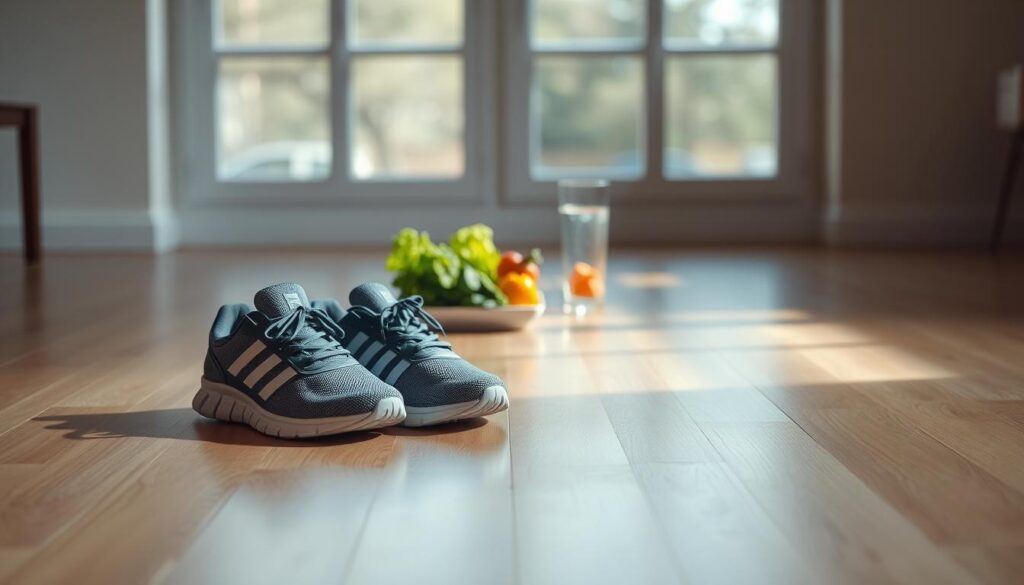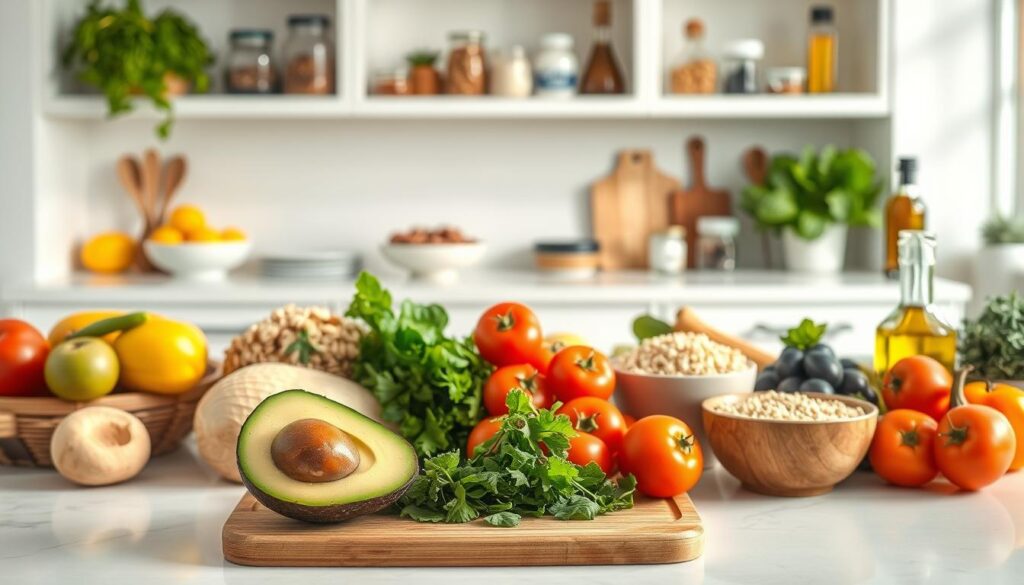Beginner’s Guide to Effective Weight Loss
Embarking on a weight loss journey can be daunting, especially for those who are new to it. You’re not alone in feeling overwhelmed by the countless diets, exercise plans, and conflicting advice available today. That’s why this Beginner’s Guide to Effective Weight Loss is designed to simplify the process and help you get started with confidence.

Effective weight loss isn’t just about following a trendy diet or hitting the gym hard for a few weeks. It’s about creating a balanced, sustainable lifestyle that supports long-term health and well-being. With so many easy weight loss tips out there, it’s important to focus on what truly works for beginners.
This Beginner’s Guide to Effective Weight Loss will walk you through the essentials—helping you understand your body, set realistic goals, and make informed decisions that lead to lasting results.
Key Takeaways
- Understand the importance of setting realistic goals
- Learn how to create a personalized weight loss plan
- Discover effective strategies for maintaining motivation
- Explore the role of nutrition in weight loss
- Find out how to incorporate physical activity into your daily routine
Understanding the Fundamentals of How to Lose Weight
The journey to a healthier you begins with understanding the fundamentals of weight loss. At its core, weight loss is about creating a balance between the calories you consume and the calories your body uses. Various factors, including your metabolism, diet, and physical activity level, influence this balance.
Understanding how to lose weight effectively starts with making informed decisions about your nutrition and exercise routines. By mastering these fundamental concepts, you can create a personalized plan that supports sustainable progress and long-term success.
The Science Behind Quick Weight Loss
This can be effectively achieved through a combination of reducing your calorie intake and increasing your physical activity levels. Quick weight loss occurs when you create a calorie deficit, meaning you consume fewer calories than your body expends.
Your metabolism plays a crucial role in this process, as it determines the rate at which your body burns calories. For sustainable and quick weight loss, it’s important to focus on healthy lifestyle changes rather than extreme dieting.
Calories In vs. Calories Out Explained
Understanding the concept of “calories in versus calories out” is essential. The calories you consume come from the food and drinks you intake, while the calories out refer to the energy your body uses for various functions, including basic metabolic functions and physical activities. A healthy weight loss plan focuses on balancing these two aspects.
| Activity Level | Calories Burned per Day | Impact on Weight Loss |
| Sedentary | 1,800 – 2,000 | Low |
| Moderately Active | 2,000 – 2,400 | Moderate |
| Very Active | 2,400 – 3,000 | High |
Why Sustainable Changes Beat Crash Diets
Crash diets may promise quick results, but they are often unsustainable and can lead to nutrient deficiencies. Making sustainable lifestyle changes, on the other hand, promotes long-term weight loss and overall health. Simple weight loss techniques, such as eating more fiber and reducing processed foods, can make a significant difference.

By focusing on gradual, sustainable changes, you can achieve your weight loss goals and maintain a healthy weight over time. Incorporating weight loss tips for starters, such as monitoring your calorie intake and increasing your physical activity, can set you up for success.
Setting Realistic Weight Loss Goals
The journey to a healthier you begins with setting practical weight loss goals. To achieve this, you need to understand what constitutes a healthy weight range and set specific targets.
Determining Your Healthy Weight Range
Your healthy weight range is influenced by factors such as age, gender, height, and body composition. Using a BMI calculator or consulting with a healthcare professional can help determine this range.
Creating SMART Weight Loss Goals
SMART stands for Specific, Measurable, Achievable, Relevant, and Time-bound. For example, aiming to lose 1-2 pounds per week is a SMART goal. This approach helps in creating quick weight loss hacks that are sustainable.

Establishing a Sustainable Timeline
Aiming for gradual weight loss ensures that the progress is maintainable. Crash diets often lead to rebound weight gain, making easy weight loss methods more desirable in the long run.
Celebrating Non-Scale Victories
Weight loss isn’t just about the number on the scale. Celebrate improvements in energy levels, overall health, and how you feel.
| Goal Type | Description | Example |
| Specific | Clearly define your goal | Losing 10 pounds |
| Measurable | Quantify your goal | Tracking weight weekly |
| Achievable | Ensure the goal is realistic | Aiming for 1-2 pounds of weight loss per week |
Nutrition Basics for Weight Loss
Mastering nutrition basics is a critical step towards achieving your weight loss goals. Understanding what you eat and how it affects your body can make a significant difference in your weight loss journey.
Understanding Macronutrients
Macronutrients are the three main categories of nutrients that provide energy and support the growth and maintenance of the body. They are carbohydrates, proteins, and fats.
Proteins: Your Weight Loss Ally
Protein is essential for building and repairing muscles, organs, and tissues. It helps you feel full, reducing the likelihood of overeating. Include protein-rich foods like lean meats, fish, eggs, and legumes in your diet.
Carbohydrates: Choosing the Right Ones
Carbohydrates are a primary source of energy. Focus on complex carbohydrates like whole grains, fruits, and vegetables, which are rich in fiber and nutrients.
Healthy Fats: Essential for Success
Healthy fats, found in nuts, seeds, avocados, and olive oil, are crucial for hormone production and absorption of vitamins. They also help keep you full and satisfied.
Portion Control Strategies for Beginners
Controlling portion sizes is vital to managing calorie intake. Use a food scale or measuring cups to gauge your portions. Eat slowly and stop when you feel satisfied, not stuffed.

Simple Meal Planning Templates
Meal planning helps you stay on track with your weight loss goals. Create a weekly meal plan, including breakfast, lunch, dinner, and snacks. Use a template to organize your meals and make a grocery list.
| Meal | Monday | Tuesday | Wednesday |
| Breakfast | Oatmeal with fruits | Scrambled eggs with spinach | Greek yogurt with berries |
| Lunch | Grilled chicken salad | Whole grain sandwich with turkey | Quinoa bowl with roasted vegetables |
| Dinner | Baked salmon with sweet potato | Grilled chicken with brown rice | Lentil soup with whole-grain bread |
By understanding and applying these nutrition basics, you’ll be well on your way to achieving your weight loss goals.
Simple Dietary Changes That Make a Big Difference
Effective weight loss often starts with simple dietary modifications that you can maintain in the long term. By making a few straightforward changes to your eating habits, you can achieve significant weight loss and improve your overall health.
Increasing Protein Intake Without Complicated Recipes
Boosting your protein intake can be easier than you think, even without complex recipes. Start by incorporating more lean meats like chicken and turkey into your meals. You can also add protein-rich foods like beans, lentils, and eggs to your diet. Consider having a protein shake as a quick breakfast or snack. Increasing protein intake helps you feel fuller for longer, reducing the likelihood of overeating.

Adding More Fiber to Naturally Reduce Calories
Adding more fiber to your diet is another simple yet effective way to support weight loss. Foods high in fiber, like fruits, vegetables, and whole grains, help you feel full and satisfied. Fiber also aids in digestion, reducing the risk of bloating and discomfort. Try to include a variety of colorful vegetables in your meals and snack on fruits throughout the day.
Reducing Processed Foods and Added Sugars
Cutting down on processed foods and added sugars can significantly impact your weight loss journey. Processed foods are often high in unhealthy fats, salt, and sugar, which can lead to weight gain. Reading food labels can help you make informed choices. Opt for whole, unprocessed foods as much as possible, and limit your intake of sugary drinks and snacks.
Hydration Habits That Support Weight Loss
Staying hydrated is crucial for weight loss. Sometimes, thirst can be mistaken for hunger, leading to unnecessary snacking. Drinking enough water throughout the day can help control hunger and boost your metabolism. Aim to drink at least eight glasses of water a day, and consider drinking a glass before meals to help with portion control.
Exercise Fundamentals for Weight Loss Beginners
As a beginner, incorporating exercise into your daily routine can be a game-changer for your weight loss journey. Regular physical activity not only burns calories but also builds muscle improves mood, and enhances overall health. The key is to start with manageable activities and gradually increase intensity and duration.
Starting a Walking Routine: Your First Step
Walking is one of the simplest and most effective ways to begin your exercise journey. It’s low-impact, requires no special equipment, and can be done almost anywhere. Aim for at least 30 minutes of brisk walking per day to kickstart your weight loss.
Basic Strength Training Without Equipment
You don’t need a gym to start strength training. Bodyweight exercises like push-ups, squats, and lunges are effective for building muscle. Start with a few repetitions and gradually increase as you build strength.
Finding Physical Activities, You Actually Enjoy
The best exercise is one you’ll stick to. Whether it’s dancing, swimming, or cycling, finding an activity you enjoy makes it easier to maintain a consistent routine. Experiment with different activities to find what works best for you.
Creating a Sustainable Exercise Schedule
Consistency is key to successful weight loss. Create a schedule that fits your lifestyle and stick to it. Aim for at least 150 minutes of moderate-intensity exercise or 75 minutes of vigorous-intensity exercise per week.
Avoiding Common Exercise Mistakes
Beginners often make the mistake of doing too much too soon. Avoid overexertion by gradually increasing the intensity and duration of your workouts. Also, remember to warm up before starting and cool down afterward to prevent injuries.
| Exercise Type | Benefits | Tips for Beginners |
| Walking | Low-impact improves cardiovascular health | Start with 30 minutes a day at a brisk pace |
| Strength Training | Builds muscle, boosts metabolism | Begin with bodyweight exercises 2-3 times a week |
| High-Intensity Interval Training (HIIT) | Efficient calorie burn improves cardiovascular fitness | Start with short intervals and gradually increase the duration |
By incorporating these exercise fundamentals into your routine, you’ll be well on your way to achieving your weight loss goals. Remember, the journey to weight loss is not just about the destination; it’s about adopting a healthier lifestyle that you can maintain in the long term.
Easy Weight Loss Tips for Beginners
You don’t need to overhaul your life to lose weight; small, manageable changes can be incredibly effective. As a beginner, it’s essential to start with simple and sustainable tips that can be maintained in the long term.
Quick Kitchen Hacks for Healthier Meals
Transforming your kitchen habits can significantly impact your weight loss journey. Start by prepping ingredients in advance, such as chopping vegetables or marinating proteins. This simple hack saves time during meal preparation and ensures you’re making healthy choices.
Another effective tip is to use herbs and spices to flavor your food instead of relying on salt and sugar. This not only reduces calorie intake but also enhances the nutritional value of your meals.
Simple Food Swaps That Save Hundreds of Calories
Making simple food swaps is a straightforward way to cut calories without feeling deprived. For instance, switching from white rice to brown rice or from regular pasta to whole-grain pasta can make a significant difference. Another swap is choosing grilled chicken or fish over processed meats.
| Food Swap | Calories Saved | Benefit |
| White Rice to Brown Rice | 110 calories per cup | Higher fiber content |
| Regular Pasta to Whole-Grain Pasta | 100 calories per serving | Increased nutrient intake |
| Processed Meats to Grilled Chicken/Fish | 200-300 calories per serving | Lower in saturated fats and higher in protein |
Time-Saving Meal Prep Ideas for Busy People
Meal prep is a game-changer for those with busy schedules. Start by designating a day for meal prep and preparing meals for the next few days. You can also use a slow cooker to prepare healthy meals that simmer throughout the day, saving time and effort.
Mindful Eating Techniques Anyone Can Master
Mindful eating involves paying attention to your hunger and fullness cues, eating slowly, and savoring your food. This practice can help reduce overeating and enhance your overall dining experience. Try eating without distractions, such as turning off the TV or putting away your phone.
Small Daily Habits That Add Up
Incorporating small daily habits can lead to significant weight loss over time. For example, taking a short walk after dinner or doing a few minutes of stretching in the morning can boost your metabolism and energy levels.
By implementing these easy weight loss tips, you can set yourself up for success on your weight loss journey.
Lifestyle Changes Beyond Diet and Exercise
Achieving successful weight loss involves more than just diet and exercise; it requires a holistic approach to lifestyle changes. Simple weight loss techniques often focus on nutrition and physical activity, but other aspects of your daily life can significantly impact your progress.
Improving Sleep Quality for Better Weight Management
Getting adequate sleep is crucial for weight regulation. Poor sleep can disrupt hormones that control hunger, leading to overeating. Aim for 7-9 hours of quality sleep per night by establishing a consistent bedtime routine and creating a sleep-conducive environment.
Stress Management Techniques That Prevent Emotional Eating
Chronic stress can trigger emotional eating and weight gain. Practicing stress-reduction techniques like meditation, deep breathing, or yoga can help manage stress levels. These activities not only calm the mind but also improve overall well-being.
Creating a Supportive Environment at Home
Your home environment plays a significant role in your weight loss journey. Remove or limit unhealthy food options, and stock up on nutritious foods. Creating a healthy kitchen environment makes it easier to make positive dietary choices.
Building a Routine That Supports Your Goals
Establishing a daily routine can help you stay on track with your weight loss goals. Incorporate weight loss tips for starters, such as scheduling meal times, planning workouts, and setting aside time for relaxation. Consistency is key to developing healthy habits that last.
Tracking Your Progress Effectively
Staying on track with your weight loss goals requires consistent and accurate progress tracking. Monitoring your progress helps you understand what’s working and what areas need improvement.
Beyond the Scale: Different Ways to Measure Success
While the scale is a common metric, it’s not the only way to measure success. Consider tracking your body fat percentage, measurements, or progress photos. You can also monitor how your clothes fit or your overall energy levels.
Smart Ways to Lose Weight Using Apps and Tools to Monitor Your Journey
There are numerous apps and tools available that support effective ways to lose weight by helping you track your diet, exercise, and overall weight loss progress. Popular options include MyFitnessPal, Lose It!, and Fitbit, which provide valuable insights to keep you on track.
| Tracking Method | Benefits |
| Weight Scale | Monitors overall weight loss |
| Body Fat Percentage | Tracks change in body composition |
| Progress Photos | Visual representation of progress |
How Often to Track Without Becoming Obsessed
Finding the right balance is key. Tracking too frequently can lead to obsession, while tracking too infrequently may cause you to lose momentum.
Adjusting Your Plan Based on Results
Regularly reviewing your progress allows you to make necessary adjustments to your diet and exercise plan, ensuring you stay on track to meet your weight loss goals.
Overcoming Common Weight Loss Challenges
The path to successful weight loss is often fraught with challenges that can derail your efforts if not addressed properly. As you work towards your weight loss goals, understanding how to overcome these hurdles is crucial.
Breaking Through Plateaus
Weight loss plateaus are a common phenomenon where your weight loss progress stalls despite maintaining your diet and exercise routine. To break through a plateau, consider adjusting your calorie intake or changing your exercise routine to include new challenges.
- Reassess your daily caloric needs as your weight changes.
- Mix up your workout routine to avoid stagnation.
- Ensure you’re getting enough sleep to support weight regulation.
Managing Cravings and Hunger Effectively
Cravings and hunger can be significant obstacles to weight loss. Strategies to manage these include staying hydrated, eating more protein, and incorporating fiber-rich foods into your diet.
- Drink water regularly to curb unnecessary snacking.
- Incorporate protein-rich foods to keep you fuller for longer.
- Choose high-fiber foods like fruits, vegetables, and whole grains.
Staying Motivated When Progress Slows
It’s normal for weight loss progress to slow down over time. Staying motivated during these periods is key to long-term success. Focus on non-scale victories, such as increased energy levels or improved overall health.
- Celebrate small victories along your weight loss journey.
- Find a workout buddy or join a weight loss support group.
- Reward yourself with non-food items, like a new workout outfit.
Navigating Social Situations and Eating Out
Social gatherings and eating out can pose challenges to your weight loss efforts. Planning, choosing healthier options, and being mindful of portion sizes can help you stay on track.
- Plan your meals when attending social events.
- Opt for healthier menu options when dining out.
- Practice mindful eating to savor your food and control portions.
Bouncing Back After Setbacks
Setbacks are an inevitable part of any weight loss journey. The key is not to let them derail your entire effort. Learn from your setbacks and get back on track as soon as possible.
- Don’t be too hard on yourself after a setback.
- Identify triggers that led to the setback and plan to avoid them.
- Get back to your healthy routine as soon as possible.
By understanding and addressing these common weight loss challenges, you can stay on track and achieve your weight loss goals more effectively. Incorporating effective weight loss tips and easy weight loss tips for beginners into your daily routine can make a significant difference in your journey toward a healthier you.
Conclusion: Your Sustainable Weight Loss Journey
Embarking on a weight loss journey can be challenging, but with the right mindset and strategies, you can achieve your goals. By understanding the fundamentals of weight loss, setting realistic goals, and incorporating simple weight loss techniques into your daily routine, you’re taking the first steps towards a healthier lifestyle.
As you’ve learned, effective weight loss is not just about dieting or exercising; it’s about adopting sustainable habits that promote overall well-being. By applying the weight loss tips for starters outlined in this guide, you’ll be better equipped to navigate common challenges and stay on track.
Remember, the key to successful weight loss is consistency and patience. Focus on making progressive changes that you can maintain in the long term rather than seeking quick fixes. With persistence and the right approach, you’ll be on your way to achieving your weight loss goals and enjoying a healthier, more balanced life.
FAQ
What are some easy weight loss tips for beginners?
You can start by making simple dietary changes, such as increasing your protein intake, adding more fiber, and reducing processed foods. Additionally, incorporating physical activity like walking or strength training can help you get started on your weight loss journey.
How do I determine my healthy weight range?
You can use a body mass index (BMI) calculator or consult with a healthcare professional to determine a healthy weight range for your height and body type.
What are some simple weight loss techniques that actually work?
Techniques like portion control, mindful eating, and meal planning can be effective for weight loss. You can also try keeping a food diary or using a tracking app to monitor your progress.
How often should I track my weight loss progress?
It’s recommended to track your progress regularly but not obsessively. You can weigh yourself once a week or track your measurements monthly to monitor your progress.
What are some effective ways to stay motivated during my weight loss journey?
Celebrating non-scale victories, finding a support system, and rewarding yourself for milestones achieved can help you stay motivated. You can also try varying your routine or seeking professional guidance to keep you on track.
How can I overcome common weight loss challenges like plateaus or cravings?
To overcome plateaus, you can try changing your exercise routine or adjusting your calorie intake. Managing cravings can be achieved by staying hydrated, eating regular meals, and having healthy snacks on hand.
Are there any quick weight loss hacks that can help me get started?
While there are no magic solutions, you can try simple hacks like drinking more water, eating more protein, or incorporating high-intensity interval training (HIIT) into your workout routine.
What are some simple dietary changes that can make a big difference in my weight loss journey?
Reducing added sugars, increasing your fiber intake, and eating more protein can make a significant impact on your weight loss efforts. You can also try meal prepping or planning your meals to help you stay on track.
Read More





